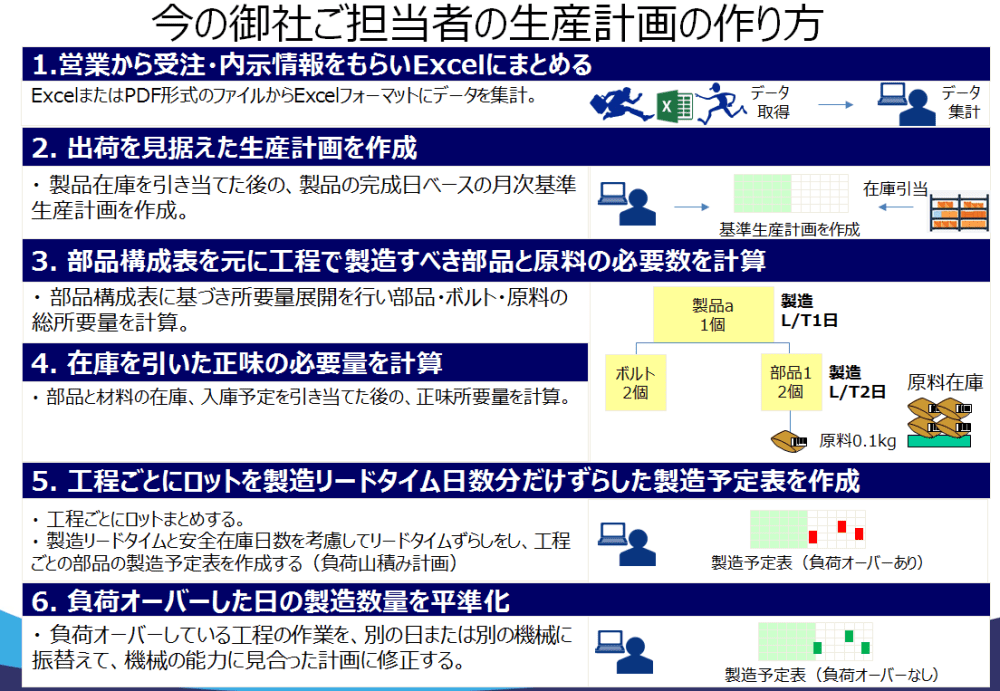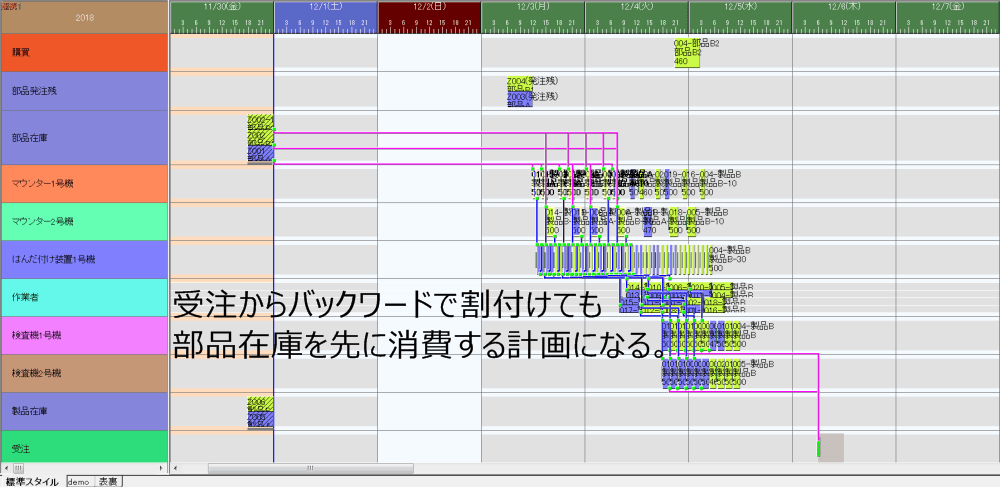Priority is given to consuming raw material inventory or manufacturing to meet shipments
In the manufacturing industry in Indonesia, a planner in the Production Planning and Inventory Control (PPIC) department generally uses the unofficial invoice and orders sent by the sales department as the basis for a production schedule (the production schedule) based on the completion date after subtracting the product inventory. We create a standard production plan (BOM) and use the BOM to develop parts to shift the manufacturing orders of disassembled work-in-process to another date, taking into account the number of days of safety stock.
As a result, manufacturing orders are piled up on the calendar, but overflow orders are moved forward or transferred to other machines to create a production plan that can be digested by the plant's production facilities.

This method of production planning is called "Backward", while the opposite method, in which work-in-progress orders are generated from the first process to the second process in order to allocate the quantity of work-in-process required for order placement, is called "Forward".
After confirming that the load is not delayed in delivery by checking the load in backward, the production plan is made ahead of schedule to the extent that it does not lead to an overstocked situation due to overproduction, and the production plan is made to increase the operating rate.
Regardless of the planning method, it is natural that the company will want to prioritize the production of raw material inventory in terms of first-in/first-out, and if the plan is forward, which starts with the first process that directly uses raw materials, it will naturally lead to a plan to consume the raw material inventory first.
On the other hand, in backward planning, which starts from the back-end process close to the shipment, manufacturing orders for in-process products are generated first to satisfy the shipment, and as a result, raw material inventory is allocated last, which may not result in a plan that prioritizes the consumption of raw material inventory.
Plan to produce first from orders with raw material inventory
In order to create a plan to produce from the raw material inventory first, the production scheduler Asprova allocates "the raw material replenishment orders generated from the backward allocation, which are tied to purchase orders and order backlogs other than inventory" at the time of backward allocation, so the plan to produce from the raw material inventory first is created by allocating the orders tied to inventory at the end.
The following allocation rules (dispatching rules) are set in descending order in order to allocate the production orders tied to orders for raw materials other than inventory first in backward.
- IF(SumIF(ME.オーダ.'子オーダ(再帰)',TARGET.品目.品目種別=='原料'&&TARGET.オーダ種別!='在庫(絶対量)',TARGET.オーダ数量)>0,1,0)

When raw material purchase orders and order backlogs are not considered in MRP (Resource Requirements Planning), the production plan can be created considering the raw material constraints by setting the raw material availability date (e.g., receiving date) to the earliest start date and time of the manufacturing order.
When the current stock of raw materials is exhausted, we will switch to another raw material
Component B2, which is used in the initial board mounting process, can be switched to component B3 after the current inventory in the warehouse has been exhausted.
- The instruction code for part B2 and part B3 of the production BOM is set to In2 as an alternative raw material.
- Set the automatic replenishment of part B2 to "No" in the item table.
- In the item table, set the raw material switching destination for part B2 to part B3.
- Set the automatic replenishment of part B3 to "Yes (stock + 1:1 production)" or "Yes" in the item table.

Production orders that do not have raw materials in stock or backlogs of orders will not be produced.
It is possible to plan production in such a way that raw material inventory or order backlog (confirmed quantity) will not be used to produce missing orders.
- Set the automatic replenishment of part A to "No" in the item table.
- Set the raw material constraint flag for Part A to "Yes" in the item table.
- Set "Yes" to impose raw material constraints on planning parameters.




